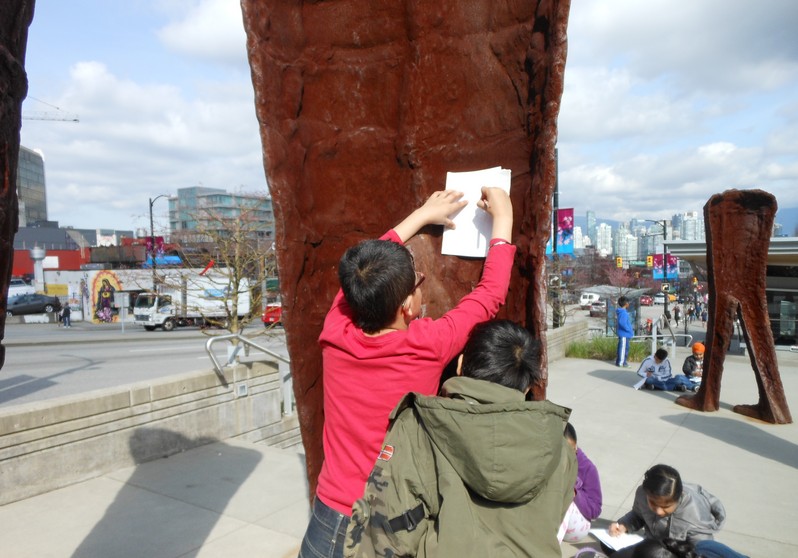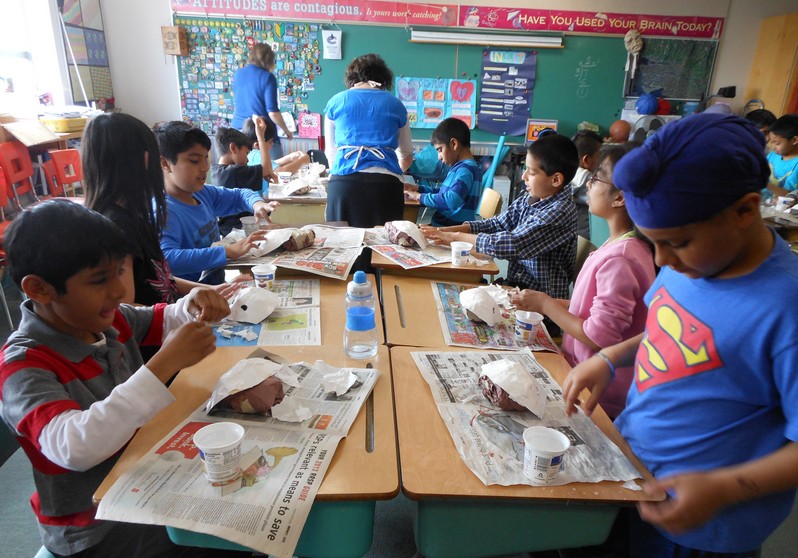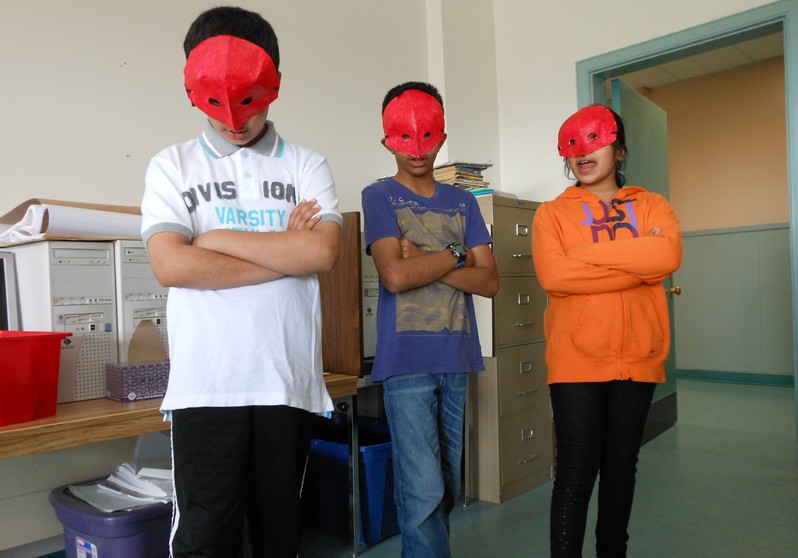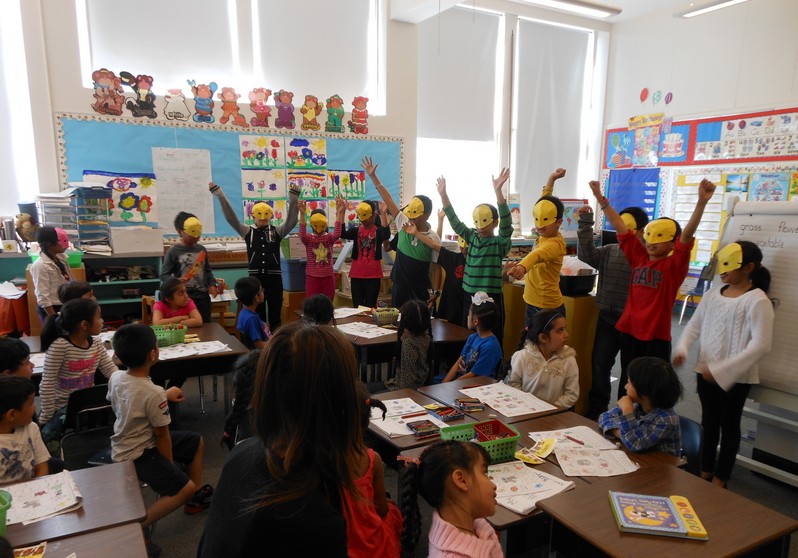Walter Moberly Gr 4 #1
Arts Education, Language Arts, Mathematics, Science, Social Studies
School
Walter Moberly Elementary, Vancouver, BC
Teachers
Dana Soga and Theresa Lopetrone
Artist
Maggie Winston
Class
Grade 4
BIG IDEAS
Who am I? Making meaning and connecting with story, text and images through exploration and inquiry deepens understanding of self, identity, and others
Guiding Questions
How do the masks individuals put on everyday change the interactions they have with others in theater and in real life?
Connection the Vancouver Biennale Exhibition
Vancouver Biennale Legacy: Walking Figures (Magdalena Abakanowicz, Poland). Students imagined the stories behind the figures while reflecting on their own identity and creating characters for the sculptures.
The curatorial theme of the 2014-2016 Vancouver Biennale exhibition is Open Borders / Crossroads Vancouver. This project connects to this theme in many ways:
• Sharing the message of exploring self-identity through performances in multi-grade classrooms throughout the school.
• Students empathize with one another and break down the barriers created by the masks individuals put on.
• Crossing curricular subjects using drama as a tool to learn about social responsibility, mathematics and social studies.
Other Sources of Inspiration
- Masks created by Maggie Winston
- Artist Alfred Pellan and his brightly coloured masks for Twelfth Night
- First Nations masks from the Museum of Anthropology
- Carl Jung’s “Archetypes”
Overview
During a visit to Walking Figures, students started to inquire into how people change when they wear a mask. They reflected on the identities and personalities of the sculptures and created characters for them based on their first impressions. Through drama and written activities, students were encouraged to use their feelings, memories, observations and past experiences to respond to the BIG IDEA “Who am I?” Working with the artist, students were challenged to think about how taking on another character gives them insight into their own identity and how the masks they put on everyday change the interactions they have with others in theater and in real life. Students created masks based on Carl Jung’s “Archetypes”, their own personalities and research done about masks used by different cultures. Working in groups and as a class, the students performed their collective responses to the question of “Who am I?” wearing bright colour masks. Students explored both performed and personal identity and the empathy and understanding that can be learnt when contemplating the masks worn by ourselves and others.
Curriculum Access
Arts Education: Character development: Students learnt about how masks can communicate their character’s identity and choose the colours that would best represent their own archetype. Using their masks, students explored movement, expression and becoming a different character. Students utilized their language skills to write lines for their archetype and collaborate on an original ensemble performance. The artist and teacher challenged students to think about how taking on another character gives them insight into their own personality and to think independently.
Language Arts: Storytelling: Students participated in many writing exercises including writing their own original script for each of their archetypes. Students learnt to use expression while speaking and to choose words that would best communicate their thoughts and ideas to an audience.
Mathematics: Units of measure can be used to compare and determine the measurable values of objects and shapes: Students applied the concept of line symmetry during the mask making process. The masks were used as props during mathematics classes on objects and shapes.
Science: Living things sense and respond to stimuli in their environment: Students inquired as to why organisms look the way they do and how they present themselves to the world. What adaptations (behavioural and/or structural) do organisms have that allow them to live in their habitats? For example: why are some poisonous animals as brightly coloured as they are? Who do some animals hide? Why do pond lilies have such large leaves?
Social Responsibility: Bullying/Empathy Challenge: The students were asked to take on the mask and character of others. How does it feel to be the bully? How does it feel to the victim? How does it feel to be the parents? How does it feel to be the teacher? Students tied the awareness of what one is feeling to empathy and the attempt to feel what others feel.
Social Studies: Economic interdependence can lead to co-operation, competition and conflict between societies: Students researched how other cultures use storytelling to pass down traditions and how are masks incorporated into these stories. Students utilized masks from First Nations cultures, visual stories from ancient civilizations such as Egypt, the Mayans and written legends to explore ways that different cultures use art and storytelling to express their identity.
Learning Process
The project was launched with an introduction to the artist, the Vancouver Biennale and had a discussion about what a “BIG IDEA” is. The students went on a field trip to Walking Figures and were challenged to identify and empathize with the figures. Exploring the guiding questions, students discussed their first impressions of the figures, imagining what their story might be. Students then drew the arms and heads of the figures, giving them personalities of their own. In class, students explored their reactions to the sculptures through movement, learning how to express different emotions and characters in the way that they walk and move. The artist introduced the students to different traits as characterised by Carl Jung’ as “Archetypes” of identity such as “The Innocent”, “The Explorer” and “The Caregiver”. The students were challenged to reflect on the different roles they play in their lives and complete a writing task where they filled in “I am a ____”. Students explored deeply which archetype described them best, thinking about their personal identities and learning about their fellow classmates.
After learning about masks used in theatre and in different cultures, students created masks out of papier-mâché, painting the masks a colour to represent their archetype. The students then worked in groups by Archetypes identity and created choreography and stances inspired by classical Greek theatre that would best communicate the personality of their archetype. They then wrote lines for their archetype answering the questions, “who am I?” “what is my motto?” and “what do I want?” Each archetype section was incorporated into a performance titled “Who am I? The Birth of the Archetypes”, that was performed for different classes in their school. At the end of the performance, students asked their audience “who am I?” taking off their masks and revealing to their peers their true identity, commenting on how masks simultaneously mask and reveal information about who we are.
Student Creation
Students created masks with papier-mâché and painted them with the colour of the archetype they most identified with. These masks were used for an original ensemble performance using movements learnt through exercises with the artist collaborator and scripted lines that communicated their archetype and character.
Taking Action
Students performed their play for multiple classes in their school. In order for the subtleties of each character to be easily seen and understood, students performed for a series of classrooms in a more intimate setting hoping to inspire other students to reflect on who they are and the masks that they wear.
Time Line
March
• Introduction to the artist and the Vancouver Biennale BIG IDEAS project
• Movement and sound exercises
• Discussion of what a “BIG IDEA” is
April
Field trip to Walking Figures and explored first reactions to the sculpture, including:
• What are the physical characteristics of the sculptures?
• What is the feeling of the sculptures?
• What are the figures doing?
• Who could they be?
• Sketched artwork and added heads and arms to create a character
Introduction to the Archetypes of Carl Jung
• Character development and movement exercises with artist Maggie Winston
• “I am __” writing exercise, writing as many descriptive or role words as they can to describe themselves
Mask Making Activities:
When the students worked on making their masks, the teacher and artist facilitated inquiries into the following questions:
What is a mask? How do you feel when you are wearing a mask? How can we use art and storytelling to learn about ourselves? About others? What masks (borders) do we put on ourselves? What masks (borders) do others put on themselves? How can we open/remove/understand/appreciate these masks? How do others see me when I have my different masks (borders) on? How do I see others? How can I cross these borders and feel safe in doing so?
The art-making process includes the following activities:
• Made brains with paper and masking tape as support for making masks.
• Made masks with papier-mâché
• Reviewed archetypes and chose a colour that represent each one to be painted on the masks
• Students chose which archetypes they are
Creating Performance:
• Broke into archetype groups and agreed on choreography for their group
• Experimented and expanded movement vocabulary
• Wrote 3 lines for their Archetype characters to be spoken during the performance:
• Who am I? I am
• Motto
• What do I want?
• Worked collaboratively to create a play from movement exercises and script
• Rehearsals and creation of titled “Who am I? The Birth of the Archetypes”
May
• Performed for different classes in the school with 8 performances in total
Reflection
Students on Art and Inquiry Experience: first Impression from students regarding Walking Figures.
The students used the following words to describe the physical characteristics of the sculptures:
Rusty, like rocks, metal, different designs, rough, nothing behind them, plain, different sizes, different clothing, making zig zags , no heads or arms, bumpy, empty behind, big, giant, no belly buttons, wrinkly, no nails or toe nails, feet bigger than normal, bare feet, claws
The students used the following words responding to the questions “How does the sculpture feel? and “How does it make them feel and how they might feel.”
Angry, happy, anxious, nervous, mad, insane, scary, neutral, curious, sad, depressed, disappointed, excited
The students used the following words responding to the question “What are they doing?
Walking, in a group walking towards an objective, marching, looking, observing, exercising, sneaking, analyzing, jogging, getting ready for a race
The students used the following words responding to the question ”Who are they?”
1st nations people, astronauts, titans, giants, soldiers, old people, big foot, zombies, scientists, wrong experiment in human making, trolls, popular people who are dead, advertisers, royalty, guards, explorers.
Teacher: Dana Soga
The most positive experience about the project is the student learning and appreciation for a new way of thinking. The artist is awesome – an asset to the program and the students love the field trip experience.
Artist: Maggie Winston
As the facilitator of “Who am I? The Birth of the Archetypes” Theatre Project at Moberly Elementary School, I am very proud of the students and happy with the results of the workshops. The students were very willing to participate in activities that were totally new to them. They responded very well to direction and offered input when I asked for their original ideas. They responded very well to the task of investigating themselves to find out which Archetype they most identified in their daily lives, truthfully expressing who they are and not just picking who they might want to be. They learned new skills with the mask making, which I think was a very fun part for them. I would have loved to have more time with them to go in depth into story making. The show produced a somewhat abstract interpretation of the Greek theatre, but it would have been great for them to create a story to theatricalize all together.





